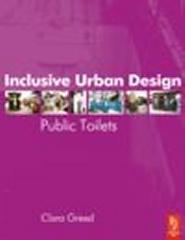This is a unique text providing both design guidance and policy direction for the provision and design of public toilets covering city-wide, district-level and site-specific principles. It highlights the role of urban design in reversing the trend of inadequate toilet provision, and sets out guidelines for design which meets both user need and provider requirements.
Greed presents the fundamental principle that toilets should not be dealt with in isolation from mainstream urban policy, but that they should be seen as a serious core component in both strategic urban policy and local area design. She argues toilets are valuable townscape features in their own right as manifestation civic pride and good urban design - essential architectural components which add to the quality and viability of an area.
Although a range of design guidance on toilets exists there is still considerable dissatisfaction with the end product in terms of building design, levels of provision, location, safety, layout, DDA requirements and accessibility. By outlining user demands and provider constraints, Greed shows that it is essential for architects to have an informed understanding and practical knowledge of toilet issues when working with public and private sector providers.
Examples of toilet architecture from other countries, and policies from different cultural settings, are included for comparative purposes to invigorate UK perspectives.
Contents
Preface; Acknowledgments; PART I THE PROBLEM; 1. The Background, Or How we got to where we are:; Introduction: Background and Context; Conceptualising the Problem of Public Toilets; The Historical Development of Toilet Provision; The Development of Toilet provision within its legal context; 2. Differing Perspectives on the Problem:; Cultural Attitudes: Separating or Mixing; Medical Perspectives: Incontinence or Incompetence; Environmental Aspects: Global and Local; PART II THE SOLUTIONS; 3. Design and Policy Change:; Planning for Toilets: City-wide Macro level; Disability or Disenablement?; Universal Urban Design: Meso level; Toilet Design Considerations: Micro level; 4. Creating Change:; Management, Maintenance and Finance; Change Makers, User and Provider Groups; Routeways to Change; KEY TO ACRONYMS; BIBLIOGRAPHY; TOILET LEGISLATION; WEB LINKS; TOILET ORGANISATION OBJECTIVES; INDEX

(0 Comentarios)